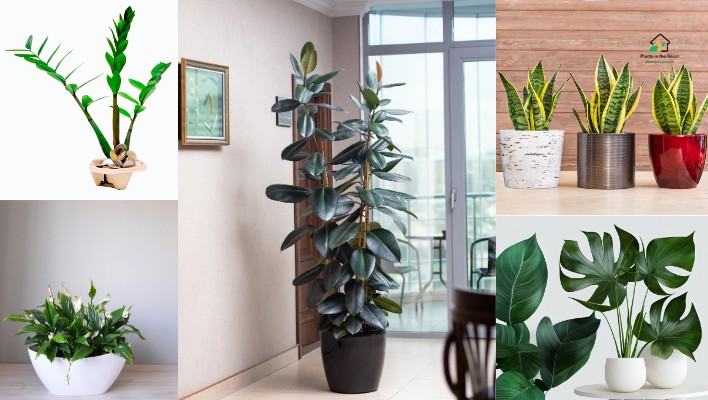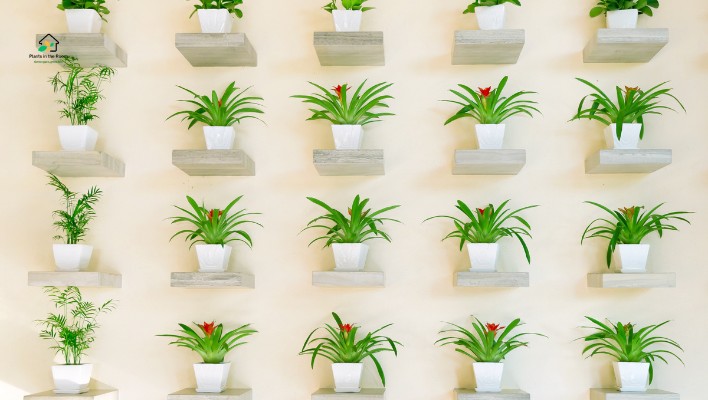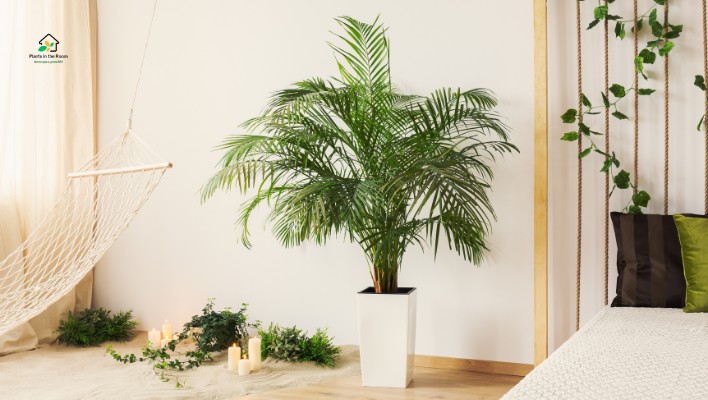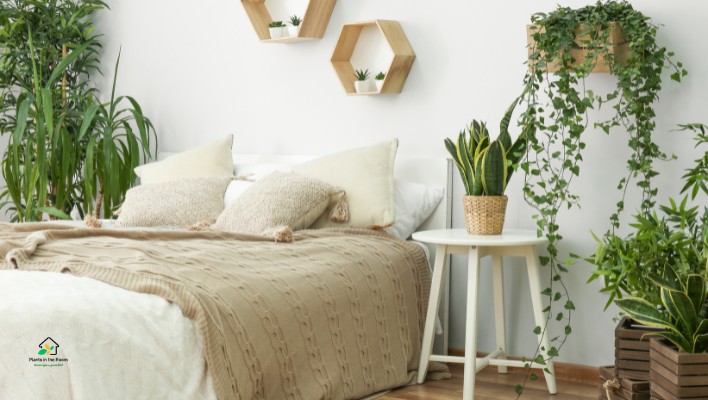This article covers the following areas –
- Finding the Perfect Spot in Your Bedroom for Your Plants
- Assessing Your Bedroom’s Light Conditions
- Choosing the Right Pots and Planters for Your Bedroom
- Adding Vertical Space in Your Bedroom
- Picking the Perfect Plants for Your Bedroom
- How to Arrange Houseplants in Your Bedroom for Maximum Impact
- Guide to Layering Your Bedroom Plants for a Lush Look
- How to Rotate Your Bedroom Plants
- How to Take Care of Your Bedroom Plants
- In Conclusion
Hi plant lovers! I’m an indoor plant lover, and today I want to share some tips on how to green up your bedroom with beautiful and easy-to-care-for indoor plants. Trust me; you don’t need to be an expert to create a cozy and refreshing bedroom sanctuary.
Choose indoor plants that thrive in your bedroom’s light conditions and display them in stylish pots that match your decor. Arrange at various heights and mix textures and colors for a visually appealing space. Remember to water, fertilize, and prune your plants to keep them healthy and vibrant.
Now let me share a complete guide on how to decorate your bedroom with indoor plants. My tips will help you to select and arrange the plants for your bedroom as well as how to take good care of them.
Finding the Perfect Spot in Your Bedroom for Your Plants

First things first, let’s talk about where to place your plants. Think about the spots in your bedroom that get the most sunlight. Window sills are great for this. Placing plants near a window lets them soak up the sun. Plus, it makes your room look more vibrant.
But don’t worry if you don’t have much natural light. Some plants, like snake plants and pothos, can thrive in low light. Place these in darker corners or on shelves to add life to every nook.
Assessing Your Bedroom’s Light Conditions
Before buying plants, it’s essential to assess your bedroom’s light conditions. Observe how much sunlight your room receives throughout the day. Notice if the light is direct or filtered.
This information will help you choose plants that will thrive in your specific environment. For instance, succulents and cacti love direct sunlight, while ferns prefer filtered light.
Choosing the Right Pots and Planters for Your Bedroom
Now, let’s discuss plant pots. There are so many options! You can go for ceramic, terracotta, or even plastic pots. Make sure they have drainage holes. This helps prevent root rot. Don’t forget to add a saucer underneath to catch excess water.
Think about your room’s style when choosing pots. Select ones that match your decor, or use contrasting colors to make a bold statement. You can also get creative with plant stands, hangers, and shelves to elevate your greenery.
Adding Vertical Space in Your Bedroom
Don’t underestimate the power of vertical space. If your bedroom has limited floor or surface area, consider using hanging planters, wall-mounted shelves, or even a trellis to display your plants.
This not only saves space but also adds an interesting design element to your room. Hanging plants like spider plants or trailing vines create a beautiful, cascading effect on your walls.
Picking the Perfect Plants for Your Bedroom

When it comes to choosing plants, start with easy-to-grow varieties. Here are a few of my favorites:
#1 Snake Plant
Snake plant is low-maintenance and great at purifying the air. These hardy plants can tolerate a range of light conditions, making them ideal for any bedroom.
#2 Pothos
Pothos is a beautiful trailing plant that can thrive in low light. Their lush, heart-shaped leaves cascade down, creating a waterfall effect.
#3 ZZ Plant
ZZ plant has shiny leaves and a tough-as-nails attitude. This plant is perfect for those who might forget to water occasionally, as it’s very drought-tolerant.
#4 Peace Lily
Peace lilies are plants of gorgeous white flowers and have excellent air-purifying abilities. This plant is a great option for adding a touch of elegance to your bedroom.
Once you’ve mastered the basics, consider expanding your plant collection with more unique varieties. Some options to explore include:
#5 Calathea
Calathea is known for its striking, patterned leaves. They add a touch of sophistication to any bedroom. Keep in mind they prefer higher humidity, so you may need to mist them regularly or use a humidifier.
#6 String of Pearls
String of pearls is a charming succulent plant that has delicate, pearl-like leaves that cascade beautifully from a hanging planter.
#7 Rubber Plant
Rubber plants make a statement in any space with their large, glossy leaves, the rubber. They can grow quite tall, so they’re perfect for filling an empty corner or adding height to your arrangement.
#8 Monstera
Monstera is a trendy choice as its large, split leaves make a bold statement. These plants can grow quite large, so make sure you have enough space to accommodate their growth.
How to Arrange Houseplants in Your Bedroom for Maximum Impact

Once you have your plants, it’s time to arrange them. Group your plants based on their needs. Put sun-loving plants together by the window. Place low-light plants further away. This makes it easier to care for them.
To create visual interest, play with different heights. Use a mix of plant stands, shelves, and hanging planters. This way, your eyes travel from one plant to the next, creating a sense of movement.
Don’t forget to mix textures and colors. Combine plants with different leaf shapes and shades of green. This adds depth and makes your bedroom feel like a true indoor oasis.
Guide to Layering Your Bedroom Plants for a Lush Look
Layering plants is a fantastic way to create a dynamic and lush arrangement in your bedroom. To achieve this stunning look, follow these simple steps:
- Assess your plants’ heights and growth habits. Take note of which plants are tall, medium, or short, as well as which ones have trailing or cascading growth patterns.
- Begin by placing the tallest plants in the back of your arrangement. This creates a visually appealing backdrop and allows the plants to receive adequate light without overshadowing smaller plants.
- Next, position medium-height plants in the middle of your display. This helps to create a sense of depth and dimension, drawing the eye toward the center of your arrangement.
- Finally, add shorter plants and those with trailing or cascading growth habits to the front. These plants will soften the edges of your display and provide a lovely contrast to the taller plants behind them.
Following this tiered approach will create a visually captivating plant display that adds depth and dimension to your bedroom sanctuary.
How to Rotate Your Bedroom Plants
Regularly rotating your plants is essential for maintaining their health and appearance. Here’s why rotating your plants is beneficial.
- Balanced Growth: Rotating your plants ensures that all sides receive equal exposure to light, promoting even growth. This prevents plants from becoming lopsided or leaning too much toward the light source.
- Pest and Disease Prevention: Regular rotation encourages better air circulation around your plants, reducing the risk of pests and diseases. It also allows you to inspect your plants more thoroughly, spotting potential issues early on.
To rotate your plants effectively, follow these steps:
- Observe the growth of your plants and identify any that appear to be leaning or favoring one side.
- Gently turn your plants so that the side that was previously facing away from the light source is now facing it.
- Repeat this process every few weeks, making sure to rotate all of your plants to maintain their overall health and appearance.
By layering and rotating your plants, you’ll create a lush, visually stunning arrangement while also ensuring your green friends stay happy and healthy.
How to Take Care of Your Bedroom Plants

Most indoor plants need water once a week. Check the soil before watering. If it’s dry, give your plant a drink. Overwatering can be harmful, so be careful not to drown your green friends. In addition, keep an eye out for pests and signs of disease. Address any issues promptly to keep your plants healthy and vibrant.
#1 Fertilizing Your Plants
To help your plants grow and thrive, it’s essential to fertilize them regularly. Most indoor plants benefit from a balanced, water-soluble fertilizer applied every four to six weeks during the growing season (spring and summer).
During the fall and winter, reduce the frequency to every eight weeks. Always follow the fertilizer package instructions to avoid overfeeding your plants, which can lead to damage or even death.
#2 Pruning and Grooming Your Plants
Regular pruning and grooming are crucial to maintaining a healthy and attractive plant collection. Remove dead or yellowing leaves to encourage new growth and prevent the spread of diseases. For trailing plants, trim the ends to promote bushier growth.
Don’t be afraid to prune your plants – it’s a natural part of their growth cycle and helps them maintain their shape and size.
#3 Creating a Humidity-Friendly Environment
Many indoor plants, especially tropical varieties, appreciate higher humidity levels. To increase humidity around your plants, you can place a tray of water near them, mist them regularly, or use a humidifier.
If you have multiple humidity-loving plants, consider grouping them together to create a microclimate that benefits them all.
In Conclusion
In conclusion, greening up your bedroom is easier than you think. Pick easy-to-care-for plants, arrange them in stylish pots, and place them in the right spots. By following these simple tips and practical suggestions, you’ll create a bedroom that’s a breath of fresh air. Happy planting!






